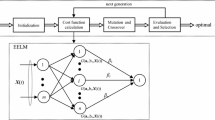Abstract
The challenge in feature selection for time series lies in achieving similar prediction performance when compared with the original dataset. The method has to ensure that important information has not been lost by with feature selection for data reduction. We present a chaotic feature selection and reconstruction method based on statistical analysis for time series prediction. The method can also be viewed as a way for reduction of data through selection of most relevant features with the hope of reducing training time for learning algorithms. We employ cooperative neuro-evolution as a machine learning tool to evaluate the performance of the proposed method. The results show that our method gives a data reduction of up to 42 % with a similar performance when compared to the literature.
Access this chapter
Tax calculation will be finalised at checkout
Purchases are for personal use only
Similar content being viewed by others
References
Crone, S.F., Kourentzes, N.: Feature selection for time series prediction-a combined filter and wrapper approach for neural networks. Neurocomputing 73(10), 1923–1936 (2010)
Chen, M., Mao, S., Liu, Y.: Big data: a survey. Mob. Netw. Appl. 19(2), 171–209 (2014)
Kohavi, R., John, G.H.: Wrappers for feature subset selection. Artif. Intell. 97(1), 273–324 (1997)
Guyon, I., Elisseeff, A.: An introduction to variable and feature selection. J. Mach. Learn. Res. 3, 1157–1182 (2003)
Yu, L., Liu, H.: Feature selection for high-dimensional data: a fast correlation-based filter solution. In: ICML, vol. 3, pp. 856–863 (2003)
Sandya, H.B., Hemanth Kumar, P., Patil, S.B.: Feature extraction, classification and forecasting of time series signal using fuzzy and garch techniques. In: National Conference on Challenges in Research and Technology in the Coming Decades (CRT 2013), IET, pp. 1–7 (2013)
Olszewski, R.T.: Generalized feature extraction for structural pattern recognition in time-series data. DTIC Document, Technical report (2001)
Cavalcante, E., Pereira, J., Alves, M.P., Maia, P., Moura, R., Batista, T., Delicato, F.C., Pires, P.F.: On the interplay of internet of things and cloud computing: a systematic mapping study. Comput. Commun. 8990, 17–33 (2016)
Chen, C.P., Zhang, C.-Y.: Data-intensive applications, challenges, techniques and technologies: a survey on big data. Inf. Sci. 275, 314–347 (2014)
Chandra, R., Zhang, M.: Cooperative coevolution of Elman recurrent neural networks for chaotic time series prediction. Neurocomputing 186, 116–123 (2012)
Takens, F.: On the Numerical Determination of the Dimension of an Attractor. Springer, Heidelberg (1985)
Potter, M.A., Jong, K.A.: A cooperative coevolutionary approach to function optimization. In: Davidor, Y., Schwefel, H.-P., Männer, R. (eds.) PPSN 1994. LNCS, vol. 866, pp. 249–257. Springer, Heidelberg (1994). doi:10.1007/3-540-58484-6_269
Chandra, R., Frean, M., Zhang, M.: On the issue of separability for problem decomposition in cooperative neuro-evolution. Neurocomputing 87, 33–40 (2012)
Mackey, M.C., Glass, L.: Oscillation and chaos in physiological control systems. Science 197, 287–289 (1977)
Lorenz, E.: Deterministic non-periodic flows. J. Atmos. Sci. 20, 267–285 (1963)
SILSO World Data Center: The International Sunspot Number (1834-2001), International Sunspot Number Monthly Bulletin and Online Catalogue, Royal Observatory of Belgium, Avenue Circulaire 3, 1180 Brussels, Belgium. http://www.sidc.be/silso/. Accessed 02 Feb 2015
Hübner, U., Abraham, N.B., Weiss, C.O.: Dimensions and entropies of chaotic intensity pulsations in a single-mode far-infrared NH3 laser. Phys. Rev. A 40(11), 6354–6365 (1989)
The Santa Fe Time Series Competition Data. http://www-psych.stanford.edu/~andreas/Time-Series/SantaFe.html. Accessed 01 May 2015
Lin, C.-J., Chen, C.-H., Lin, C.-T.: A hybrid of cooperative particle swarm optimization and cultural algorithm for neural fuzzy networks and its prediction applications. IEEE Trans. Syst. Man Cybern. Part C Appl. Rev. 39(1), 55–68 (2009)
Ardalani-Farsa, M., Zolfaghari, S.: Residual analysis and combination of embedding theorem and artificial intelligence in chaotic time series forecasting. Appl. Artif. Intell. 25, 45–73 (2011)
Menezes, J.M.P., Barreto, G.A.: Long-term time series prediction with the NARX network: an empirical evaluation. Neurocomputing 71(16), 3335–3343 (2008)
Teo, K.K., Wang, L., Lin, Z.: Wavelet packet multi-layer perceptron for chaotic time series prediction: effects of weight initialization. In: Alexandrov, V.N., Dongarra, J., Juliano, B.A., Renner, R.S., Tan, C.J.K. (eds.) ICCS-ComputSci 2001. LNCS, vol. 2074, pp. 310–317. Springer, Heidelberg (2001)
Chandra, R.: Competition and collaboration in cooperative coevolution of Elman recurrent neural networks for time-series prediction. IEEE Trans. Neural Netw. Learn. Syst. 26(12), 3123–3136 (2015)
Mirikitani, D., Nikolaev, N.: Recursive bayesian recurrent neural networks for time-series modeling. IEEE Trans. Neural Netw. 21(2), 262–274 (2010)
Author information
Authors and Affiliations
Corresponding author
Editor information
Editors and Affiliations
Rights and permissions
Copyright information
© 2016 Springer International Publishing AG
About this paper
Cite this paper
Hussein, S., Chandra, R. (2016). Chaotic Feature Selection and Reconstruction in Time Series Prediction. In: Hirose, A., Ozawa, S., Doya, K., Ikeda, K., Lee, M., Liu, D. (eds) Neural Information Processing. ICONIP 2016. Lecture Notes in Computer Science(), vol 9949. Springer, Cham. https://doi.org/10.1007/978-3-319-46675-0_1
Download citation
DOI: https://doi.org/10.1007/978-3-319-46675-0_1
Published:
Publisher Name: Springer, Cham
Print ISBN: 978-3-319-46674-3
Online ISBN: 978-3-319-46675-0
eBook Packages: Computer ScienceComputer Science (R0)




